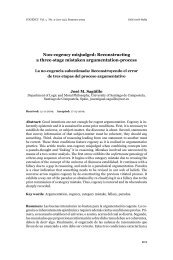Cogency v2 n2
Cogency v2 n2
Cogency v2 n2
Create successful ePaper yourself
Turn your PDF publications into a flip-book with our unique Google optimized e-Paper software.
COGENCY Vol. 2, N0. 2, Spring 2010<br />
ticular attention to the interpretive challenge posed by his provocative and<br />
deliberate evolution away from definite assertions in philosophical matters<br />
and towards creating interpretive tensions in his readers in order to achieve<br />
greater clarity in the long run – albeit with less dogmatic confidence. They<br />
argue that this challenge can be met only after achieving the perspective that<br />
comes from having worked through the Tractatus. While their conclusions<br />
are largely negative concerning the place for arguments in Wittgenstein’s<br />
philosophy, conceptual space is created for a more positive account of argument<br />
both in philosophy and in general.<br />
In “ ‘A Picture Held us Captive’: The Later Wittgenstein on Visual Arguments”<br />
Steven Patterson shows how the views of the later Wittgenstein, particularly<br />
his views on images and the notion of “picturing,” can be brought<br />
to bear on the question of whether there are such things as “purely visual”<br />
arguments. He draws on Wittgenstein’s remarks in the Blue and Brown<br />
Books and in Philosophical Investigations in order to argue that although<br />
visual images may occur as elements of argumentation, broadly conceived,<br />
it is a mistake to think that there are purely visual arguments, in the sense<br />
of illative moves from premises to conclusions that are conveyed by images<br />
alone, without the support or framing of words.<br />
One issue that evolved from On Certainty is the question of deep disagreements.<br />
In “The Logic of Deep Disagreements” (Informal Logic, 1985),<br />
Fogelin claimed that there was a kind of disagreement – deep disagreement<br />
– which is, by its very nature, impervious to rational resolution. He further<br />
claimed that these two views are attributable to Wittgenstein. In their paper,<br />
David Godden and William Brenner focus on this issue. Following an<br />
exposition and discussion of that claim, we review and draw some lessons<br />
from existing responses in the literature to Fogelin’s claims. In the final two<br />
sections (6 and 7) they explore the role reason can, and sometimes does,<br />
play in the resolution of deep disagreements. In doing this they discuss a<br />
series of cases, mainly drawn from Wittgenstein, which they take to illustrate<br />
the resolution of deep disagreements through the use of what we call<br />
“rational persuasion.” They conclude that, while the role of argumentation<br />
in “normal” versus “deep” disagreements is characteristically different, it<br />
plays a crucial role in the resolution of both.<br />
Although in this introduction I have commented on the papers in a thematic<br />
order, in this special issue the papers have been arranged in alphabetic order.<br />
18








